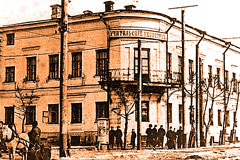
The reforms of Peter I added new features to Tatar culture and public opinion of the second half of the XVII century.
The number school became the first secular elementary school in the Kazan province.
In 1723 in Kazan there was opened the first Slavonic-Latin School for children of clergy; up to 60 students could receive education there at a time. In 1733 it was turned into Theological Seminary. In 1758 in Kazan appeared the first Gymnasia for children of the noble, merchants and officials. In1786 came into life the main public college for children of bourgeoisie and raznochinetz. Famous poet G.R.Derzhavin was also native of this land and studied in the Kazan Gymnasia.
The opening of Gymnasia stimulated the development of science. People began to study oriental languages and history of their land.
Among the Tatars who received Moslem education there greatly increased interest towards secular science, literature and education upon the whole. The ideas of the enlightened absolutism were widely spread.
In the Tatar society there were appearing new social groups – merchants and manufactory owners. It caused inevitable changes of the Tatar culture. The former state of the culture, its exclusive religious content didn’t suit the new social layers any more. The culture had to convey the social changes. The new cultural requirements were expressed in the works of G.Utiz Imyany (1756-1834), T.Yalchigul (1768-1838), A.Kursavy (1776-1812).
In 1770-s in Kazan there were founded Akhundov and Apanaev medrese, and in 1780 – one more medrese attached to Amirkhanovs’ house. At the end of this century such medrese appeared in little settlements and towns of the Kazan province; they were very popular among the Tatar population of the Volga and Ural regions. These educational institutions contributed much to the spreading of literacy among Tatar population.
One of the most well-known representatives of the Tatar fiction of that period was Utiz Imyany. A new genre appeared in the Tatar literature, it was “seyakhatname” – “travel notes”. The most famous were Ismagil Bekmukhamedov’s “notes” on his trip to India.
In the literature of that period of great significance was Michael Verevkin (1732-1795), the first Headmaster of the Kazan Gymnasia, who wrote poetry and a number of outstanding plays.
Poet Gavrila Kamenev (1772-1803), whom Pushkin called the fore-runner of Russian romanticism, was well-known all over Russia.
There was a literary society in Kazan, that introduced the most important news of the literary world to Kazan community.
In 1791 in Kazan there was founded the first permanent public theatre which gave birth to Russian drama theatre. Theatrical companies lived and worked in different estates as well.

The most important event at the beginning of the XIX century undoubtedly was the foundation of the Kazan Imperial University in 1804. On November,17 the Emperor Alexander I signed the university law, the first paragraph of which formulated the purposes of this establishment: “The Kazan Imperial University is the higher educational establishment, where the youth should be trained for different spheres of public service”. There were 4 departments at the University: the Department of Moral Law and Politics, the Department of Physics and Mathematics, Medical Department and Philological Department. There were founded 28 chairs, and the deans, as well as the rector were elected only for a year. According to the University law there should be “28 professors, 12 junior scientific assistants, 3 lecturers (or teachers of French, German and Tatar), 3 teachers of Arts and Physical Education”.
On February, 14, 1805 there took place the official opening of the University, which was quartered in the building of the first male gymnasia. Both establishments had been working side by side for 10 years, then in 1813 the Gymnasia moved to the new building at the Black lake, which was specially bought and reconstructed for this purpose (today’s K.Marx Street, 10). From the first years of its existence the University influenced the life of the whole city. Though, according to Pr. N.Bulich (1824-1895), the noble at first were rather indifferent to the new ideas brought by the University.
In 1806 within the precincts of the University there was formed the Kazan society of home literature lovers, which was the first literary association in the Volga region.
In 1808 there came into life University printing-house, which in 1811 started printing weekly “Kazan Proceedings” and in 1821 – the newspaper “Kazan Herald”. | 




























 History of culture before the year 1804
History of culture before the year 1804 












